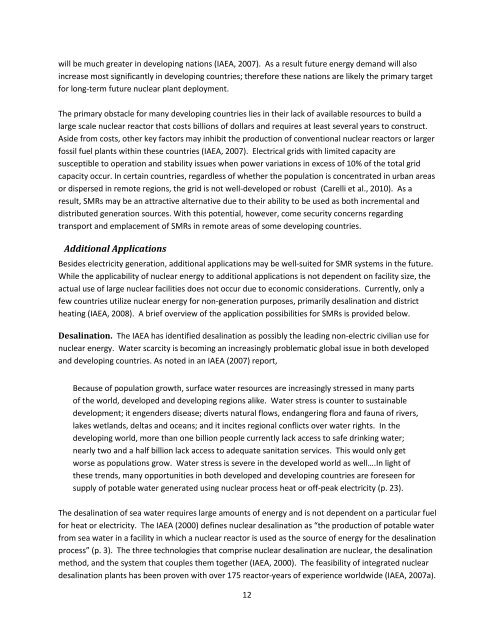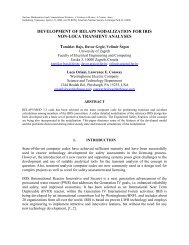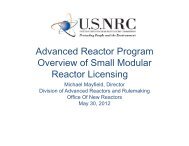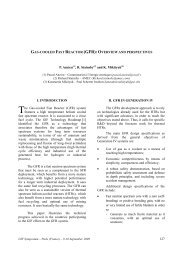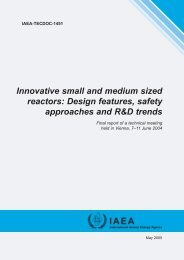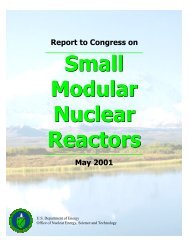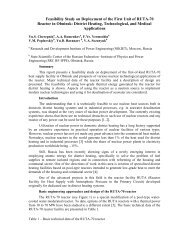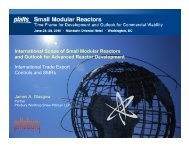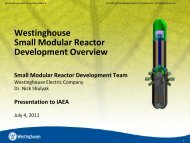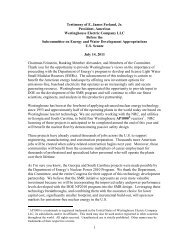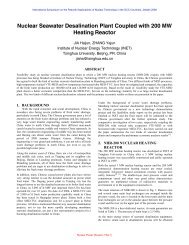Economic and Employment Impacts of Small Modular Reactors - SMR
Economic and Employment Impacts of Small Modular Reactors - SMR
Economic and Employment Impacts of Small Modular Reactors - SMR
- No tags were found...
You also want an ePaper? Increase the reach of your titles
YUMPU automatically turns print PDFs into web optimized ePapers that Google loves.
will be much greater in developing nations (IAEA, 2007). As a result future energy dem<strong>and</strong> will also<br />
increase most significantly in developing countries; therefore these nations are likely the primary target<br />
for long-‐term future nuclear plant deployment.<br />
The primary obstacle for many developing countries lies in their lack <strong>of</strong> available resources to build a<br />
large scale nuclear reactor that costs billions <strong>of</strong> dollars <strong>and</strong> requires at least several years to construct.<br />
Aside from costs, other key factors may inhibit the production <strong>of</strong> conventional nuclear reactors or larger<br />
fossil fuel plants within these countries (IAEA, 2007). Electrical grids with limited capacity are<br />
susceptible to operation <strong>and</strong> stability issues when power variations in excess <strong>of</strong> 10% <strong>of</strong> the total grid<br />
capacity occur. In certain countries, regardless <strong>of</strong> whether the population is concentrated in urban areas<br />
or dispersed in remote regions, the grid is not well-‐developed or robust (Carelli et al., 2010). As a<br />
result, <strong>SMR</strong>s may be an attractive alternative due to their ability to be used as both incremental <strong>and</strong><br />
distributed generation sources. With this potential, however, come security concerns regarding<br />
transport <strong>and</strong> emplacement <strong>of</strong> <strong>SMR</strong>s in remote areas <strong>of</strong> some developing countries.<br />
Additional Applications<br />
Besides electricity generation, additional applications may be well-‐suited for <strong>SMR</strong> systems in the future.<br />
While the applicability <strong>of</strong> nuclear energy to additional applications is not dependent on facility size, the<br />
actual use <strong>of</strong> large nuclear facilities does not occur due to economic considerations. Currently, only a<br />
few countries utilize nuclear energy for non-‐generation purposes, primarily desalination <strong>and</strong> district<br />
heating (IAEA, 2008). A brief overview <strong>of</strong> the application possibilities for <strong>SMR</strong>s is provided below.<br />
Desalination. The IAEA has identified desalination as possibly the leading non-‐electric civilian use for<br />
nuclear energy. Water scarcity is becoming an increasingly problematic global issue in both developed<br />
<strong>and</strong> developing countries. As noted in an IAEA (2007) report,<br />
Because <strong>of</strong> population growth, surface water resources are increasingly stressed in many parts<br />
<strong>of</strong> the world, developed <strong>and</strong> developing regions alike. Water stress is counter to sustainable<br />
development; it engenders disease; diverts natural flows, endangering flora <strong>and</strong> fauna <strong>of</strong> rivers,<br />
lakes wetl<strong>and</strong>s, deltas <strong>and</strong> oceans; <strong>and</strong> it incites regional conflicts over water rights. In the<br />
developing world, more than one billion people currently lack access to safe drinking water;<br />
nearly two <strong>and</strong> a half billion lack access to adequate sanitation services. This would only get<br />
<br />
these trends, many opportunities in both developed <strong>and</strong> developing countries are foreseen for<br />
supply <strong>of</strong> potable water generated using nuclear process heat or <strong>of</strong>f-‐peak electricity (p. 23).<br />
The desalination <strong>of</strong> sea water requires large amounts <strong>of</strong> energy <strong>and</strong> is not dependent on a particular fuel<br />
roduction <strong>of</strong> potable water<br />
from sea water in a facility in which a nuclear reactor is used as the source <strong>of</strong> energy for the desalination<br />
The three technologies that comprise nuclear desalination are nuclear, the desalination<br />
method, <strong>and</strong> the system that couples them together (IAEA, 2000). The feasibility <strong>of</strong> integrated nuclear<br />
desalination plants has been proven with over 175 reactor-‐years <strong>of</strong> experience worldwide (IAEA, 2007a).<br />
12


